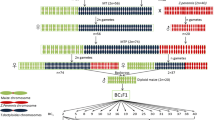Summary
In an attempt to discover ‘A’ and ‘B’ genome donor(s) to finger millet, Eleusine coracana, or its progenitor species, E. africana (both allotetraploid 2n=4x=36), five diploid species, E. Indica, E. Floccifolia, E. multiflora, E. tristachya and E. intermedia, were crossed to finger millet and its progenitor taxon. Crosses were successful only with E. coracana. Three combinations of triploid hybrids E. coracana x E. indica, E. coracana x E. floccifolia, and E. coracana x E. multiflora were obtained and analysed. Meiotic behaviour was perfectly normal in parental species. The regular number of 18 bivalents in E. coracana, 9 bivalents in E. indica, E. intermedia, E. tristachya and E. floccifolia and 8 bivalents in E. multiflora were invariably noticed. In E. coracana x E. indica hybrids a mean chromosome pairing of 8.84I+8.80II+0.03III+0.10IV per cell was found. About 86.5% of the cells showed the typical 9I+9II configuration, suggesting that E. indica (AA) is one of the diploid genome donors to cultivated species E. coracana. A mean chromosome pairing of 11.08I+7.63II+0.16III+0.04IV per cell was found in E. coracana x E. floccifolia hybrids. Two to ten bivalents and varying numbers of univalents were seen in 55% of the cells. About 45% of the cells showed the 9I+9II configuration. Various evidence suggests that perennial E. floccifolia is a primitive member of the ‘A’ genome group of Eleusine species, and it may not be a genome donor to E. coracana. In E. coracana x E. multiflora hybrids (2n=26) mean chromosome pairing of 21.45I+1.97II+0.13III+0.04IV per cell was found. About 91% of the cells were observed to have 20–26 univalents. Only a small percentage of the cells contained bivalents or multivalents. This pairing behaviour indicates that E. multiflora lacks genomic homology with the ‘A’ or ‘B’ genome of E. coracana. Genomically E. multiflora is a distinct species and a genomic symbol of ‘C’ is assigned to it. Identification of the ‘B’ genome donor species to cultivated millet. E. coracana remains elusive.
Similar content being viewed by others
References
Celariar RP (1956) Tertiary butyl alcohol dehydration of chromosome smears. Stain Technol 31:155–157.
Chennaveeraiah MS, Hiremath SC (1973) Genome relationship of itEleusine tristachya and E. floccifolia. J Cytol Genet 8:1–5.
Chennaveeraiah MS, Hiremath SC (1974a) Genome analysis of Eleusine coracana (L.) Gaertn. Euphytica 23:489–495.
Chennaveeraiah MS, Hiremath SC (1974b) Character association pattern in Eleusine Gaertn. Karnatak Univ J Sci 19: 257–275.
Chennaveeraiah MS, Hiremath SC (1991) Cytogenetics of minor millets. In: Tsuchiya T, Gupta PK (eds) Chromosome engineering in plants: genetics, breeding and evolution. Eisevier Sci Pub, Amsterdam, The Netherlands, pp 613–627.
Gottschalk W (1985) Polyploidy and its role in the evolution of higher plants. In: Sharma AK, Sharma A (eds) Advances in chromosome and cell genetics. Oxford and IBH, New Delhi, pp 1–43.
Gottschalk W (1987) III Mutation: higher plants. Prog Bot 49:216–230.
Hilu KW (1988) Identification of the “A” genome of finger millet using chloroplast DNA. Genetics 118:163–167.
Hiremath SC, Chennaveeraiah MS (1982) Cytogenetical studies in wild and cultivated species of Eleusine (Gramineae). Caryologia 35:57–69.
Jackson RC (1985) Genomic differentiation and its effect on gene flow. Syst Bot 10:391–404.
Jauhar PP, Crane CF (1989) An evaluation of Baum et al.'s assessment of the genomic system of classification in the Triticeae. Am J Bot 76:571–576.
Kaul MLH, Murthy TGK (1985) Mutant genes affecting higher plant meiosis. Theor Appl Genet 70:449–466.
Kihara H (1930) Genomanalyse bei Triticum und Aegilops. I. Cytologia 2:106–156.
Kimber G, Alonso LC, Sallee PJ (1981) The analysis of meiosis in hybrids. I. Can J Genet Cytol 23:209–213.
Phillips SM (1972) A survey of the genus Eleusine Gaertn. (Gramineae) in Africa. Kew Bull 27: 251–270.
Richardson WL (1958) A technique of emasculating small grass florets. J Genet 18:69–73.
Riley R, Chapman V (1958) Genetic control of the cytological diploid behaviour of hexaploid wheat. Nature 183:713–715.
Salimath SS (1990) Cytology and genome relations in some species of Eleusine and its allies. Ph.D thesis, Karnatak University, Dharwad, India.
Solbrig OT (1968) Fertility, sterility and the species problem. In: Heywood VH (ed) Modern methods in plant taxonomy. Academic Press, London pp 77–96.
Wang RRC (1989) An assessment of genome analysis based on chromosome pairing in hybrids of perennial Triticeae. Genome 32:179–189.
Author information
Authors and Affiliations
Additional information
Communicated by K. Tsunewaki
Rights and permissions
About this article
Cite this article
Hiremath, S.C., Salimath, S.S. The ‘A’ genome donor of Eleusine coracana (L.) Gaertn. (Gramineae). Theoret. Appl. Genetics 84, 747–754 (1992). https://doi.org/10.1007/BF00224180
Received:
Accepted:
Issue Date:
DOI: https://doi.org/10.1007/BF00224180




